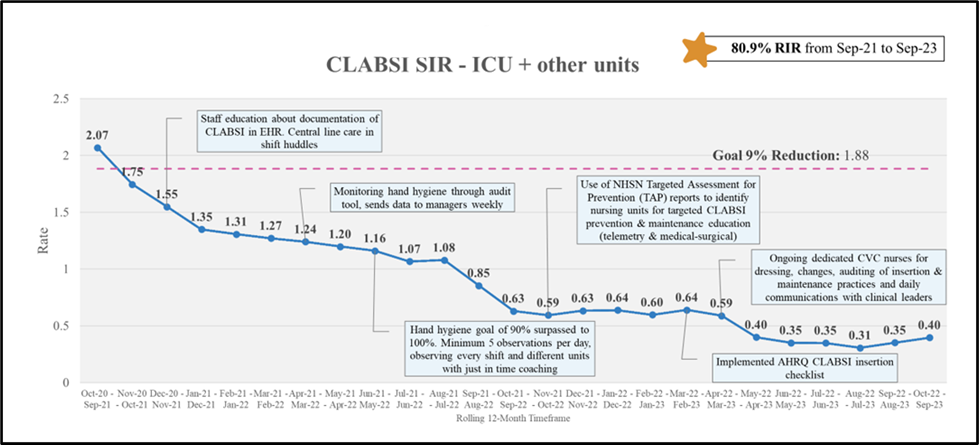
Through its role as a Health Quality Improvement Contractor (HQIC), Health Quality Innovators (HQI) assisted a large Mississippi hospital to boost its central line-associated blood stream infection (CLABSI) relative improvement rate by 80.9% from September 2021 to September 2023.
During this timeframe, 34.87 total harms were avoided, and 5.23 lives were saved for an estimated cost savings of $1,977,330.98. Cost savings and lives saved were calculated using methodology recommended by CMS based on the white paper titled Estimating the Additional Hospital Inpatient Cost and Mortality Associated with Selected Hospital Acquired Conditions.
HQI worked with the hospital to implement the Centers for Disease Control and Prevention (CDC) National Healthcare Safety Network (NHSN) Targeted Assessment for Prevention (TAP) Reports to identify nursing units for targeted CLABSI prevention and maintenance education. The TAP Strategy is a quality improvement framework that uses data to recommend actions that prevent HAIs by targeting hospitals with an excess burden of infections, assessing for gaps and implementing prevention strategies.
TAP reports provide information on HAIs needed to assess infection prevention goals in a hospital. Through the hospital TAP report, causative bacterium with insertion practices and two hospital units (telemetry and medical-surgical), were identified as leading contributors to CLABSI events. HQI assisted the hospital with completing a Plan-Do-Study-Act (PDSA) cycle. Opportunities for improvement included:
- Hire dedicated central line nurses
- Increase staff knowledge of CLABSIs, targeting nurses and night and weekend hospital staff whose knowledge may vary on this topic
- Improve CLABSI documentation in the hospital’s electronic health record (EHR)
- Provide additional hand hygiene protocols to support a reduction in CLABSI rates
As a result, with HQI tools and guidance, the hospital implemented the following strategies to reduce CLABSI infection rates:
Hired additional nursing staff – The hospital hired nurses with expertise in maintaining, monitoring and using central venous catheters. They provide documentation of CLABSI protocols in the hospital EHR that were previously omitted and work closely with the hospital infection preventionist and quality department to share efforts to decrease CLABSIs.
Daily shift huddles – To increase CLABSI knowledge, these daily, short meetings were led by a trained central venous catheter nurse and held for general nursing staff to learn the teaching definitions of CLABSI; maintaining, monitoring and using central venous catheters; and proper use of dressing for the catheter site. HQI provided the hospital with the AHRQ CLABSI Insertion Checklist, which outlines sequential critical steps for central line insertion. The hospital uses the checklist during insertion and removal procedures.
Improved CLABSI documentation – The addition of central venous catheter nursing staff improved CLABSI documentation in the hospital EHR. These nurses are responsible for entering and maintaining CLABSI data and information, in addition to educating staff nurses on CLABSI documentation in the EHR.
Education and monitoring of hand hygiene– The team incorporated an educational hand hygiene learning module that all hospital staff was required to complete every month. For every CLABSI, the hospital manager completed an event tool and root cause analysis (RCA). All hospital managers who create an event tool must present infections and RCAs at monthly CLABSI/CAUTI reduction committee meetings. Hand hygiene is monitored through an EHR audit tool and data is sent to hospital managers weekly.
The hospital’s hand hygiene goal of 90 percent escalated to 100 percent. A minimum of five observations per day were completed – observing every shift and different units with “just in time” coaching that spontaneously occurs when hospital managers observe an opportunity for a hospital staff member to be coached.
Additionally, at HQI’s recommendation, the hospital incorporated a nasal sanitizer antiseptic to reduce the risk of infection for patients by killing bacteria in the nasal vestibule. This product also aids in the prevention of other types of HAIs, such as catheter-associated urinary tract and surgical site infections.
